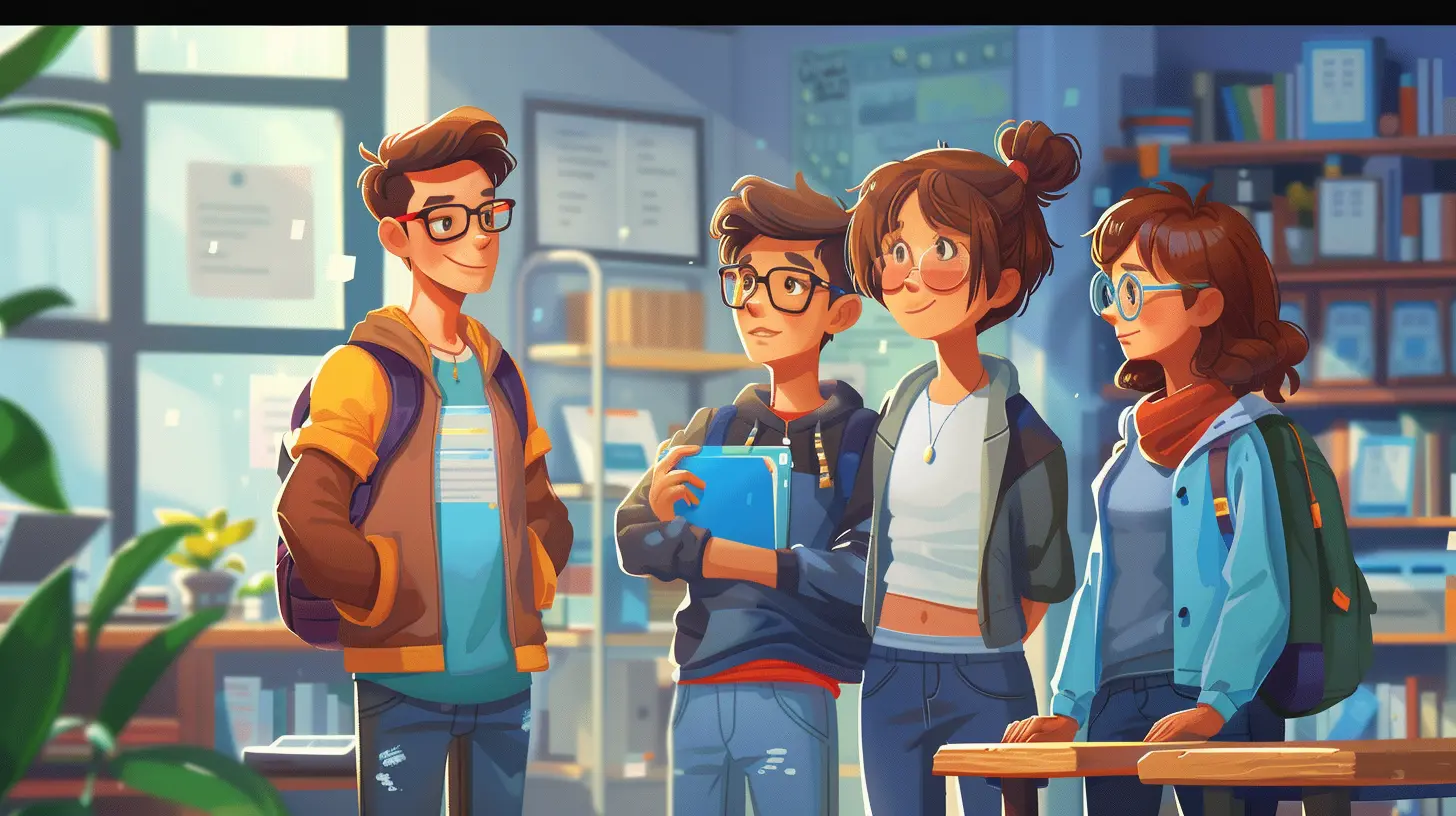How Interactive Storytelling is Reshaping Educational Games
22 November 2025
Let’s be real for a second—traditional learning methods can be painfully dull. We've all been there: staring blankly at textbooks or zoning out during a dry lecture. But what if we could make learning feel more like playing our favorite story-driven video game? That’s not just wishful thinking anymore. Interactive storytelling is turning educational games into immersive experiences that teach, engage, and downright entertain.
So buckle up, because we're diving headfirst into how interactive storytelling is flipping the script on educational games—and what it means for gamers, educators, and the whole learning ecosystem.
What Even Is Interactive Storytelling?
Before we get too wild with the hype, let’s ground ourselves. Interactive storytelling is basically narrative with agency. Imagine you’re playing a game where your choices actually matter, where the plot twists based on your actions. And we're not talking about just clicking through boring text boxes. We're talking about rich, branching storylines, emotional arcs, and gameplay mechanics that fuse storytelling with learning.Think of it like a "choose your own adventure" book on steroids—but with graphics, sound, mechanics, and a touch of gameplay magic.
The Power of Story: Why Narratives Matter in Learning
Let’s face it—stories stick. We remember feelings, not facts. That’s why you’re more likely to recall the plotline of your favorite RPG than the chapters in your 8th-grade math book.Storytelling tugs at our emotions. When emotions get involved, our brains light up like a pinball machine. Studies have even shown that storytelling activates areas of the brain related to memory, sensory experience, and decision-making. So when you combine story with interactive gameplay? Boom. You’ve got a learning powerhouse.
From Passive Learning to Active Engagement
Interactive storytelling changes the game—literally and figuratively. Educational games used to be more about rote repetition and skill drills. Think spelling games or pixelated math blasters. Functional? Sure. Fun? Eh, not so much.But with interactive storytelling, players aren’t just passive learners. They become the protagonists of their own learning journeys. You're not just solving equations—you’re saving a kingdom by cracking math puzzles. You're not just reading history facts—you’re time-traveling to ancient Rome to decide the fate of an empire.
That’s next-level engagement right there.
How Interactive Storytelling Is Changing the Game (Pun Totally Intended)
1. Learning Goes Beyond the Basics
Let’s say you’re playing a language-learning game that uses interactive storytelling. Instead of repeating phrases parrot-style, you're navigating a world as a detective trying to solve a mystery in Spanish. Suddenly, grammar and vocab aren’t just tasks—they’re tools you need to uncover clues, question suspects, and piece together the plot.You’re using language in context. And guess what? That’s how we learn best. Story-based scenarios mimic real-world situations, making the knowledge stick like glue.
2. Emotional Connection Accelerates Retention
Ever cried during a game? Or felt rage when a beloved NPC betrayed you? That emotional bond is storytelling gold. When educational games add emotionally-driven characters and consequences, players feel something. And when feelings are involved, memory retention goes through the roof.Emotion is the cheat code for engagement AND retention. And interactive storytelling hands it to us on a silver platter.
3. Decision-Making Builds Critical Thinking
Interactive storylines thrive on choices. Do you save the orphanage or stop the villain? Do you side with the rebels or the empire? These choices force players to think critically, consider long-term consequences, and make decisions under pressure—skills that are ridiculously valuable in and outside the classroom.Educational games that leverage this? They’re not just teaching facts—they’re teaching life skills.
Real-World Examples of Story-Powered Educational Games
Let’s name-drop a few legends in this space:- "Mission US" – This game throws you into different periods of American history with interactive narratives that change based on your choices. It’s like Assassin’s Creed with less stabbing and more learning.
- "The Oregon Trail" – A classic. Back in the day, this game blended resource management with survival storytelling. And yes, you probably died of dysentery. We all did.
- "Quandary" – A brilliant ethics-based game that challenges players to make tough decisions while considering the perspectives of different characters in a fictional space colony.
- "Lure of the Labyrinth" – A math-centric adventure filled with puzzles, monsters, and story-based challenges. You actually want to solve algebra because it helps you progress the plot.
These aren’t just games with educational frosting—they’re story-rich experiences that teach through immersion.
Why This Matters for Game Developers and Educators
Alright developers, listen up. If you’re building educational games without a narrative layer, you’re missing out. Adding interactive storytelling doesn’t just make your game cooler—it multiplies its learning impact.And educators? Interactive story-based games can be your secret weapon. Use them to make abstract concepts digestible, boost classroom engagement, and reach different types of learners. Visual learners, auditory learners, kinesthetic learners—interactive storytelling gets them ALL on board.
The Science Behind the Magic
Let’s sprinkle a bit of neuroscience in here. Don’t worry, it’s not boring.When we play interactive story games, multiple areas of the brain are activated: language, sensory processing, motor activity, and—wait for it—empathy.
Empathy?! Yup. When you step into the shoes of a character, especially in a learning scenario, you start to see the world from different perspectives. That builds social awareness, emotional intelligence, and even cultural sensitivity. Try doing that with a flashcard app.
Challenges and Pitfalls to Watch Out For
Alright, it’s not all sunshine and XP. There are hurdles.- Over-complication: Some games get so wrapped up in the storyline that the educational content takes a backseat. That's a fail. Balance is key.
- Cost and development time: Crafting rich narratives and branching storylines takes effort (and cash). But the payoff? Massive.
- One-size-fits-all storytelling: Different learners relate to different narratives. A model that worked in one classroom might bomb in another. Diversity in storytelling matters.
- Measurable Outcomes: Unlike quizzes or standardized tests, measuring the success of a story-based game can be tricky. Developers and educators need better analytics to understand what works and what doesn’t.
Solve these problems, and we’re looking at the future of learning, folks.
The Future of Educational Games Is Story-Driven
Let’s be blunt: the future is narrative. As game engines get stronger and AI tech allows for personalized plotlines, we’re going to see educational games that adapt in real-time to a player’s learning style, mood, and decisions.Imagine a grammar game that adjusts its story arc depending on whether you're an introvert who likes solo missions or a social butterfly who loves dialogue trees. Or a science game where you rewrite the laws of physics in a sci-fi universe—if you can prove the math.
We're not far off.
Why You Should Care (Even If You're Not a Gamer)
Still on the fence? Maybe you’re an educator, a parent, or just someone who hasn’t picked up a controller since the PS2 days. Here's the thing—you don’t need to be a gaming nerd to understand the value here.Interactive storytelling reintroduces joy into education. It creates a space where failure is safe, curiosity is rewarded, and learning feels like living out a fantasy novel. Who wouldn’t want that for their kid—or heck, even themselves?
TL;DR – Key Takeaways
- 📚 Interactive storytelling turns learning into immersive experiences.- 🧠 Emotions + choices = better memory + deeper understanding.
- 👾 Educational games are shifting from quizzes to quests.
- 🎮 Real games like "Mission US" and "Quandary" are paving the way.
- 🔮 Future games will adapt stories dynamically for each learner.
- 💪 Educational games with narrative build real-world skills—like empathy, decision-making, and critical thinking.
Final Thoughts: Education Just Leveled Up
Gone are the days of passive edutainment. With interactive storytelling leading the charge, educational games are finally earning respect not just as teaching tools, but as full-fledged entertainment masterpieces. They’re engaging, emotional, and effective.So next time someone says video games rot your brain? Tell them it’s called “interactive narrative-based skill acquisition.” Then go play an educational story game and save the world while learning calculus. No big deal.
all images in this post were generated using AI tools
Category:
Interactive StorytellingAuthor:

Stephanie Abbott

